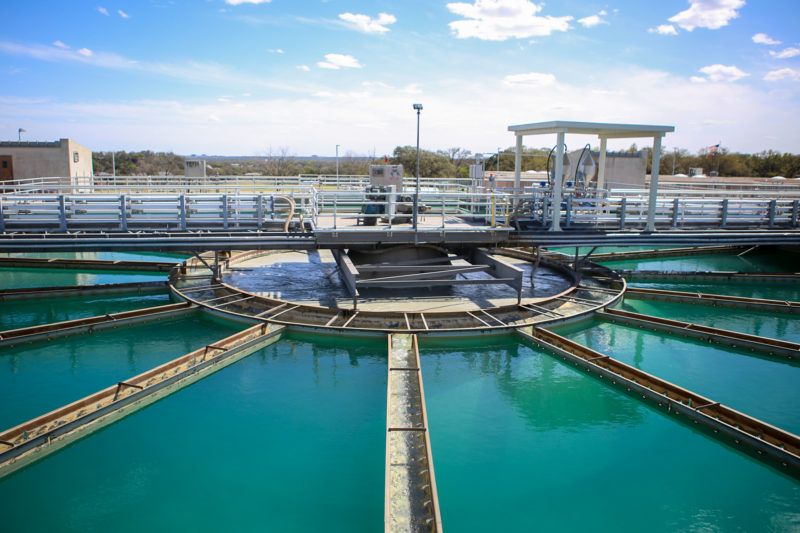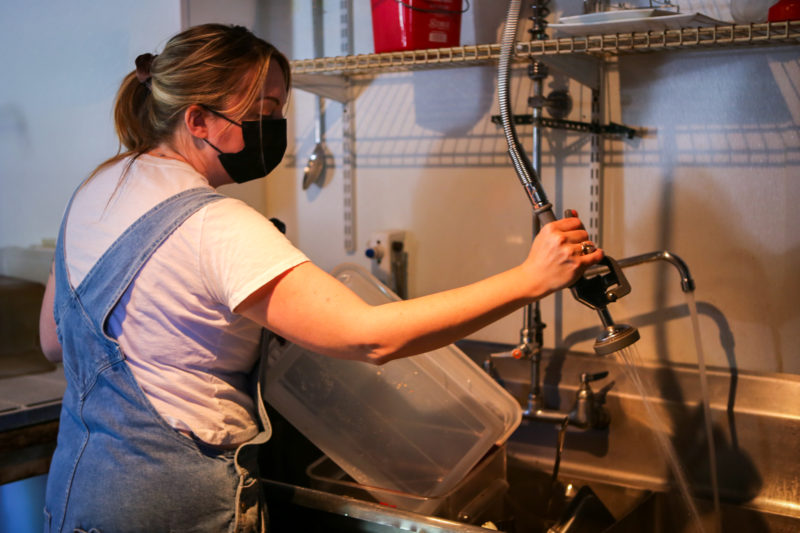From Lake to Tap: How Austin’s Water Becomes Safe to Drink
By Veronica Apodaca
Reporting Texas

A primary clarifier separates solids from wastewater at the Ullrich Water Treatment Facility in Austin on March 23, 2022. All solidified material will sink to the bottom of the tank and eventually be pumped to a sludge processor, dried and hauled away to be turned into compost. Brooke Barrett/Reporting Texas
Next to Lake Austin, the Ullrich Water Treatment Plant sits surrounded by grassy fields concealing wells that store processed water. Water ripples over filters and fills huge basins that take on the appealing look of an outdoor swimming pool.
This water, however, will mainly be used for drinking by Austin residents, who use about 130 million to 140 million gallons of water every day.
Few of those residents know how their water gets to them each day — except when things go wrong, as they did in February when problems at Ullrich resulted in a citywide boil-water notice. For three days, residents were told to purify the water coming from their taps. It was the third such boil-water notice since 2018 and led to the resignation of Austin Water’s director, Greg Meszaros.
An internal investigation found that errors by workers at the Ullrich plant resulted in unsafe water reaching the pipes that supply the city. A visit to the facility provided an opportunity to learn more about the boil-water notice and how the plant operates.
“The process of cleaning water is something that requires a lot of moving parts,” Austin Water operations manager Stephanie Sue said. “There’s a lot of aspects to it, to get from the lake into the pipe.”
The water that is used by the Ullrich Water Treatment Plant, one of three water-purification plants for Austin, begins its journey in Lake Austin, along with the multitude of debris that makes it undrinkable.
In order to begin the treatment that will transform it into drinkable water, it is first pumped from the lake into the plant’s large basins, each with a surface area of approximately 10,000 square feet. As the water travels from the lake through the pumps, it goes through a physical-chemical treatment process as it is treated with chemicals including fluoride, chlorine, ammonia and carbon.
These chemicals are used for both disinfection and to adjust the pH balance of the water to a drinkable level. Once the water and the chemicals are in the basin, limestone is added to filter out heavy metals, and the mixing process begins.
This process is accomplished by huge turbines within the basin. Their job is to mix the water, chemicals and limestone thoroughly. This allows the particles of debris to congeal together into a larger mass, known as sludge, that can be removed from the water intended for drinking. Once the sludge clumps together and moves toward the bottom of the basin, it is withdrawn into a separate storage area.
The sludge is hauled away by trucks. They transport it to Austin Water’s biosolids facility, where it is used to create compost.
At this point, it is important for the water’s chlorine and turbidity levels to be checked. Turbidity refers to the cloudiness of the water. Turbidity is usually lowered during the mixing and filtering processes. When turbidity rises above a certain level, steps such as a boil-water notice are taken in order to make sure that it is not being caused by harmful pollutants.
“You can have turbid water, that doesn’t necessarily mean you’ve found a contaminant in it,” Sue said. “Because of the water clarity issue, though, there’s a higher likelihood that there could be contaminants, but it doesn’t necessarily mean that we’ve found something in the water.”
Nearing the end of the six- to 10-hour process, the water is much cleaner than when it was first pumped in from the lake, but there are still small pieces of dirt, such as sand grains, as well as bacteria, that were not picked up by the sludge. This is where filters, which resemble large metal grates, come in. They catch the debris that is left over from the mixing process, leaving the water clean and ready to be stored in underground tanks before being pumped into the city’s water distribution system, which consists of 4,000 miles of pipes throughout Austin.

Barista Nicole Lewis washes a sink full of dishes at Bennu Coffee in Austin on April 5, 2022. Though the shop was forced to close during the fall 2018 water boil, it was able to stay open in February due to a stockpile of filtered water staff now keeps on hand. Brooke Barrett/Reporting Texas
In the case of the notice in February, there was high turbidity in the water coming from one of the basins in the Ullrich plant, which resulted in the overloading of filters, according to findings from Austin Water’s investigation. The flow from the basin to the filters was meant to have been stopped when the turbidity rose above normal levels. According to the internal investigation, workers did not stop the water flow, in spite of multiple alarms in the plant, and failed to report the increasingly turbid water conditions. As a result, the water flow continued overnight and was only turned off the following morning.
As the internal review progressed, the treatment plants focused on what is called their production capacity capability, Sue said. This means that more basins will continue to be in use at one time, particularly during the winter, when most maintenance work is done. In addition, Meszaros stated in a city press release that the department is working on improving remote monitoring, as well as training and communication between employees in order to keep the water purification process moving efficiently and prevent future issues.
“Somebody on the operations side described it once as, ‘We make water,’” said Amy Petri, Austin Water’s marketing services manager. “It really does sort of feel like a factory. There’s just these different steps along the way to make sure that it meets all of our regulatory standards to come out of that pipe and be safe to drink.”